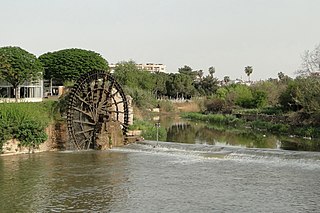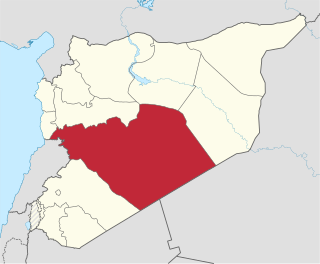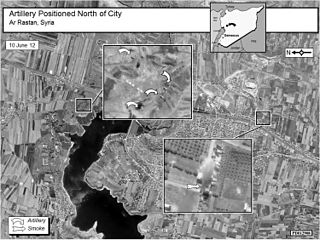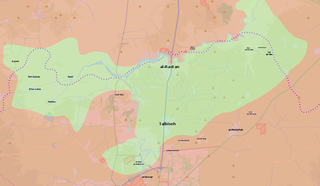
The Orontes or Nahr al-ʿĀṣī, or simply Asi is a 571 kilometres (355 mi) long river in Western Asia that begins in Lebanon, flowing northwards through Syria before entering the Mediterranean Sea near Samandağ in Hatay Province, Turkey.

Homs Governorate is one of the fourteen governorates (provinces) of Syria. It is situated in central Syria. Its geography differs in various locations in the governorate, from 40,940 km2 (15,807 sq mi) to 42,223 km2 (16,302 sq mi). It is geographically the largest governorate in Syria. Homs Governorate has a population of 1,763,000 as of 2010. The Homs governorate is divided into six administrative districts (mantiqah), with the city of Homs as a separate district. Homs is the capital city of the district of Homs. Its governor is Namir Habib Makhlouf.

Al-Rastan is the third largest city in the Homs Governorate, located 25 kilometers (16 mi) north of its administrative capital Homs and 22 kilometers (14 mi) from Hama. Nearby localities include Talbiseh and al-Ghantu to the south, al-Zaafaraniyah and al-Mashrafah to the southeast, Murayj al-Durr to the northeast, Tumin to the north, Deir al-Fardis to the northwest and Kafr Nan and the Houla village cluster to the west. Ar-Rastan had a population of nearly 40,000 in 2004.

Ar-Rastan District is a district of the Homs Governorate in central Syria. The administrative centre is the city of al-Rastan. At the 2004 census, the district had a population of 127,806.

Lake Homs is a lake near Homs, Syria, fed by the Orontes River. The Orontes is also the lake's main outflow. The lake is 15 km (9.3 mi) from the city of Homs, and spans over 60 km2 (23 sq mi).

The Lake Homs Dam, also known as Qattinah Dam, is a Roman-built dam near the city of Homs, Syria, which is in use to this day.
The siege of Rastan and Talbiseh was an operation by the Syrian Army during the Syrian revolution. On 28 May 2011, after protests and an armed revolt, the Syrian Army launched an operation in al-Rastan, a city of an estimated 50,000 residents located 20 kilometers north of Homs, and the neighboring town of Talbiseh, which resulted in the suppression of the protests and numerous deaths. The Syrian Army met some armed opposition during the siege.

A second battle between the Syrian Army and the Free Syrian Army for control of the city of Rastan took place from 29 January to 5 February 2012. Located in Homs Governorate, Rastan is a city of 60,000 residents. The FSA captured Rastan after days of intense fighting, according to residents and the opposition.

The Battle of Rastan between the Syrian Armed Forces and the Free Syrian Army took place in the city of Rastan on 14 May 2012, during the U.N. brokered cease-fire of the Syrian uprising.
Teir Maalah is a town in central Syria, administratively part of the Homs Governorate, just north of Homs. Other Nearby localities include al-Dar al-Kabirah to the southwest, al-Ghantoo to the northwest, Talbiseh to the north and al-Mukhtariyah. According to the Central Bureau of Statistics (CBS), Teir Maalah had a population of 7,728 in the 2004 census.
Murayj al-Durr is a village in northern Syria, administratively part of the Homs Governorate, located northeast of Homs and southeast of Hama, on the eastern bank of the Orontes River. Nearby localities include the district center al-Rastan to the west, Ghor al-Assi to the north, Izz al-Din to the west and al-Zaafaraniyah to the south. According to the Syria Central Bureau of Statistics (CBS), Murayj al-Durr had a population of 295 in the 2004 census, making it one of the smallest localities in the al-Rastan nahiyah ("subdistrict"). Most of its inhabitants are Circassians.
Jarjisa is a village in northwestern Syria, administratively part of the Hama Governorate, southwest of Hama. It is situated on the eastern banks of the Orontes River, the border between the governorates of Hama and Homs. Nearby localities include Tumin to the east, al-Rastan to the southeast, Kafr Nan to the southwest, Hirbnafsah to the west, Deir al-Fardis to the northwest and al-Biyah to the north.
The Mahardah Dam, also spelled Mhardeh Dam, is an embankment dam on the Orontes River in the city of Mahardah, Hama Governorate, Syria. It was completed in 1960 with the primary purpose of irrigation and a capacity of 54,000 acre feet. It was constructed by the Bulgarian firm Hydrostroy along with the al-Rastan Dam, which is upstream and also on the Orontes.
Gharnatah or al-Ghajar is a village in northern Syria, administratively part of the Rastan District, located north of Homs. According to the Syria Central Bureau of Statistics (CBS), Gharnatah had a population of 5,366 in the 2004 census. Its inhabitants are predominantly Sunni Muslims of Turkmen descent.
Asiliyah is a village in northern Syria, administratively part of the Rastan District, located north of Homs on the southern banks of the Orontes River. According to the Syria Central Bureau of Statistics (CBS), Asiliyah had a population of 360 in the 2004 census. Its inhabitants are predominantly Circassians from the Bzhedug and Shapsugh tribes.
Abu Hamamah is a village in northern Syria, administratively part of the Rastan District, located north of Homs on the southern banks of the Orontes River. According to the Syria Central Bureau of Statistics (CBS), Abu Hamamah had a population of 255 in the 2004 census. Its inhabitants are predominantly Circassians from the Shapsugh tribe.

The Orontes River offensive was a military operation launched by the Syrian Arab Army against rebels during the Syrian Civil War on the administrative border of the Hama Governorate and Homs Governorate, along the Orontes River.
The Khalid ibn al-Walid Brigade, originally called the Khalid ibn al-Walid Battalion, was a Syrian rebel group affiliated with the Free Syrian Army which was active during the Syrian Civil War. The group was one of the first FSA-affiliated rebel groups to be formed in Syria. It operated in the Homs Governorate and participated in the Siege of Homs from 2011 to 2014, when it went defunct.
The Northern Homs offensive was launched by the Syrian Armed Forces against the rebel pocket in the northern Homs Governorate and the southern Hama Governorate on 15 April 2018. It came after the defeat of the rebel forces in the final government offensive against rebels in eastern Ghouta. Following negotiations with Syrian and Russian military officials, rebels surrendered the northern Homs pocket on 2 May, and those who refused to stay were fully evacuated on 16 May. Subsequently, the Syrian government regained full control of the area.

The siege of Northern Homs was a siege lasting six years, by the Syrian government in the northern part of the Homs Governorate during the Syrian civil war, as a result of the rebel capture of Rastan and surrounding areas in 2012, the rebel-held pocket in northern Homs was fully taken by the Syrian government in 2018 after clearing opposition held areas around the capital.











